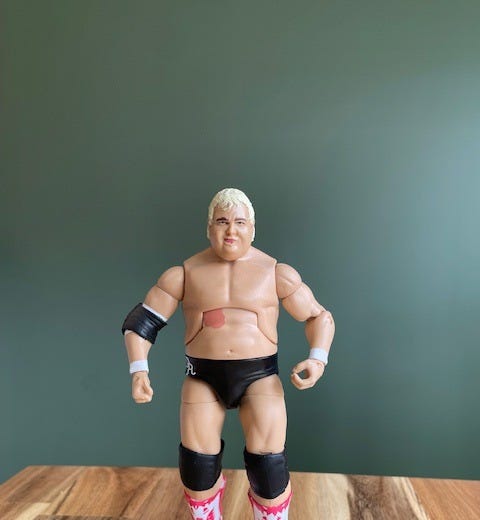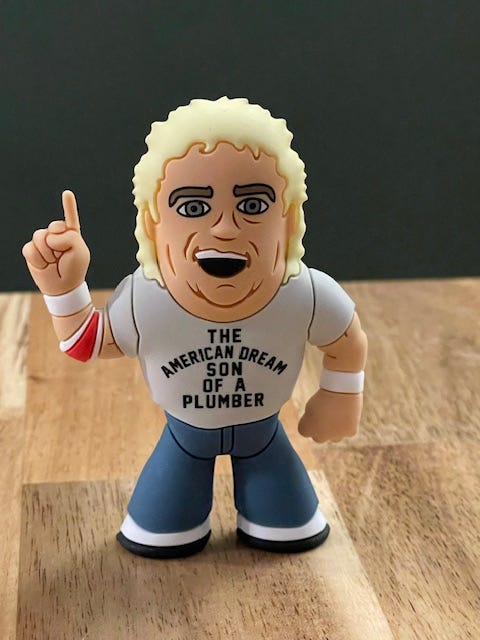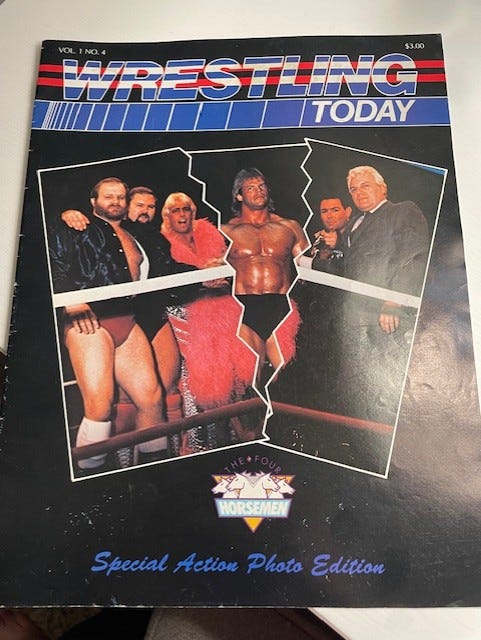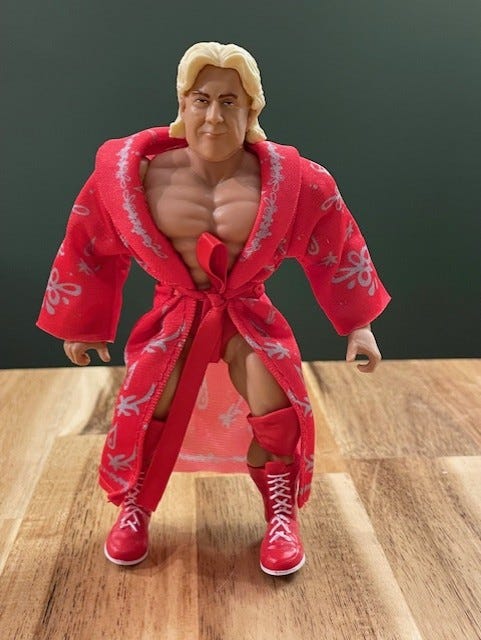
Dusty Rhodes was one of the most popular pro wrestlers on the scene when I first tuned into NWA television programs in 1986.
This charismatic wrestling hero had the ideal foe too.
Or foes, plural, I should say.
There was an ’80s era pro wrestling faction that dominated in their time and the centerpiece of the faction was the world champion for much of their glorious run.
They changed members several times over, but the original incarnation of this group is the one likely best remembered by pro wrestling fans who witnessed them wrestle back then.
Pro wrestling fans like me.
I’m referencing the original Four Horsemen: Ric Flair, Tully Blanchard, Arn Anderson and Ole Anderson, with manager J.J. Dillon.
My initial introduction to them as a viewer is the reason of why this group is so memorable to me after watching so much wrestling for the last forty years.
It shocked me as a viewer to see.
It was referred to as the parking lot incident, and it’s where members of The Four Horsemen broke Dusty Rhodes’ arm far away from the ring.
The footage of the whole incident is only a few minutes long.
It was the fall of 1986, and the NWA was leading up to Starrcade 86 where Dusty Rhodes would be defending his NWA TV title against Tully Blanchard in a First Blood match.
This was an exciting time in pro wrestling in general.
WWE was coming off WrestleMania 2 and Hulkamania was “running wild.” WWE was all about gimmicks. The territory system and the regional promotions associated with it were in rapid decline and would largely be extinct by the end of the decade. The wrestling war of the mid 80s was quickly narrowing down to WWE vs NWA, and to a lesser degree, AWA. The NWA and AWA had formed an alliance two years prior called Pro Wrestling USA to combat the rapidly expanding WWE, but by early 1986 the alliance had dissolved.
WWE was the promotion you identified with wrestling gimmicks. Everyone was a character, more or less. You had wrestlers such as Jake “The Snake” Roberts, “Birdman” Koko B. Ware, and “Rowdy” Roddy Piper, and all the WWE wrestlers were presented as varying degrees of cartoonish.
NWA was a southern-based promotion, and it felt grittier to me as a viewer.
In NWA, the wrestlers were not packaged with gimmicks like in the WWE sense. The NWA wrestlers were in essence just themselves and there was basic, yet highly effective, storylines built around grudges and feuds. Everything in NWA had a rawer, edgier element to it when compared to WWE for me as a new wrestling fan.
I enjoyed both promotions and watched all of their shows and attended live events on a monthly basis for each, but I most definitely had strong preference towards NWA.

THE PARKING LOT INCIDENT IN FOCUS
The parking lot incident footage aired on one of the NWA syndicated shows.
The footage opens inside a car. It’s very shaky camerawork, and the footage looks like it was shot with one of those ’80s camcorders that people used to film their vacations with back then.
It’s raining a little bit outside, and you hear this voice off camera talking. It’s clearly Ole Anderson. He is ordering someone to film and there’s a loose narration by him that’s just enough to establish what is going on, and it provides a sense of realism.
This type of footage on a wrestling show was different back in 1986 and it felt groundbreaking.
Rewatching it now nearly forty years later, it still feels groundbreaking. There is a very real feeling about this footage. The amateur, wobbly camerawork played a part in this. The whole idea clearly was to present this as rough camerawork, to play into the cameraman’s jitteriness due to the implied idea that he was being forced to film this. The idea was to not have professional camerawork, and that is some of the beauty of it.
Ole, and whoever else is in this car with him, follow Dusty Rhodes in his car. We learn that Dusty is driving to the Jim Crockett Promotions/NWA headquarters/office.
When Dusty gets out of his car in the small office parking lot, Arn and Ole Anderson are suddenly on him, mauling him. Everything happens very quickly. Again, it’s the realism of the way this looks that was so powerful and makes this memorable now and shocking then.
J.J. Dillion’s there with Ole and Arn, and he’s kicking Dusty. There’s a quick glimpse of Tully Blanchard, on crutches and wearing an Adidas sweatsuit, hobbling past a corner of the camera lens to get in some hits.
Everything is happening very fast, in real-time, and when it was airing on syndication on the first run you couldn’t pause it and “rewind it” back. Rather, you just watched it all as it was happening, feeling like an eyewitness to it all.
Next, they restrain Dusty Rhoades arms against his truck. There’s a ladder attached to one side of the truck, so they tie each arm to the ladder. A bat comes into the frame of the camera and the image on the screen freezes,
Then you hear Dusty screaming and the implication is they broke his arm.
This was a couple of minutes of very intense footage, and it served as a powerful set up for the upcoming Starrcade 86 grudge match between Dusty and Tully.

THE ALPHAS YOU(I) LIKED
The Four Horsemen were the first “bad guys” in pro wrestling that I cheered for.
At live events I use to attend every month for the NWA at my local arena (called house shows back then), the majority of the audience cheered The Four Horseman loudly.
It surprised me at first and was also fascinating for a new wrestling fan like me to witness.
They were clearly defined villains but there was still something likeable about them to me as a viewer. Others clearly felt the same.
What was it?
Well, for me at least, they were dominant, they were winners and, well, they were likeable alpha males.
You know, the superstar athletes of the school that had lots of charisma, were funny, everything admired them, but yet they were friendly to every single person regardless of social status, and you would have been happy to let them cheat off your tests precisely because they were so likable.
They were rare breeds.
They were real alphas.
We had Tully Blanchard and Ric Flair with these expensive-looking designer suits they were always wearing. Then we had the ruggedness of the Andersons, who both looked like they would severely hurt anyone who showed them disrespect. J.J. Dillion was perfectly cast as an intellectual mouthpiece in the manager role and did very impactful talking on promos.
To see them in person was an experience. Some of my favorite memories of them as a fan live, though, occurred outside the actual arena.
Back then at my local arena for NWA shows, it was a known fact among the regulars that all the wrestlers typically entered the building through a back entrance that was right off the street.
The mid-card and preliminary wrestlers were often on foot, walking across the street from a hotel, and if they were “good guys” they would stop to sign autographs and pose for pictures. They seemed to genuinely enjoy the attention from fans too.
The upper card and main event wrestlers all arrived by car.
The Four Horsemen arrived by limo.
When fans would see the limo turning the corner to make its way to the arena, they gathered on the sides of the small driveway that led to the back entrance door.

The Four Horsemen were one of the few groups of main event level wrestlers in a car that would always acknowledge the presence of the fans.
If you flashed The Four Horsemen hand signal, there was a high probability that one or more Horsemen members would roll down their window and flash it back at you. Sometimes Flair would let out his signature Wooooo.
In one unforgettable occasion, the limo stopped, Flair got out, climbed onto the roof and danced to the delight of the fans. He mimicked the same hyper foot shuffling he often did on TV when he got riled up during a promo.
The original Four Horseman themselves as a unit were done by the following year after the parking lot incident occurred.
Lex Luger was brought into the NWA from the Florida territory in early 1987 and on his debut, he was made an associate of the Four Horsemen. Soon after, Ole Anderson was kicked out and Lex Luger, who was presented as a hot prospect and had only been wrestling for a little over year, was made a full-fledged member of The Four Horsemen.
However, it was the original combo of Flair, Blanchard, Arn and Ole that made a lasting impression on me as a viewer.
Whenever I think about The Four Horsemen I think of them.
* You can subscribe for free to The Pro Wrestling Exuberant to receive all my new posts via email, as well as new episodes of my podcast, Only The Best Independent Wrestling.
* I’m looking for other writers who are interested in collaborating with me on some pro wrestling writing post ideas I have:
Other pro wrestling writers
Writers who are fans of pro wrestling but have never written about it.
Writers who are curious about pro wrestling but have never watched it.
Send me a direct message on Chat on Substack or comment here if you’re interested.
* If you like my pro wrestling writing, please consider upgrading to a paid subscriber for $5 a month to get exclusive content, like posts about and pictures of wrestling memorabilia from the ‘80s to present from my personal collection, as well as subscriber exclusive audio recording about ‘80s/’90s pro wrestling and original manuscripts, with updated commentary, of pro wrestling magazine articles I wrote in the ‘80s and ‘90s.
* Follow me on Bluesky for more pro wrestling content.




Two things:
1) This angle with the Horsemen in the parking lot breaking Dusty’s arm is one of my favorite things in wrestling ever.
2) I’d potentially be interested in collaborating. Depends on what you’re looking to do.
Loved this—can’t believe I’d never heard of the parking lot beatdown before. The Horsemen had such presence. Cool to see how different the vibe was in NWA—felt a lot more raw and personal.